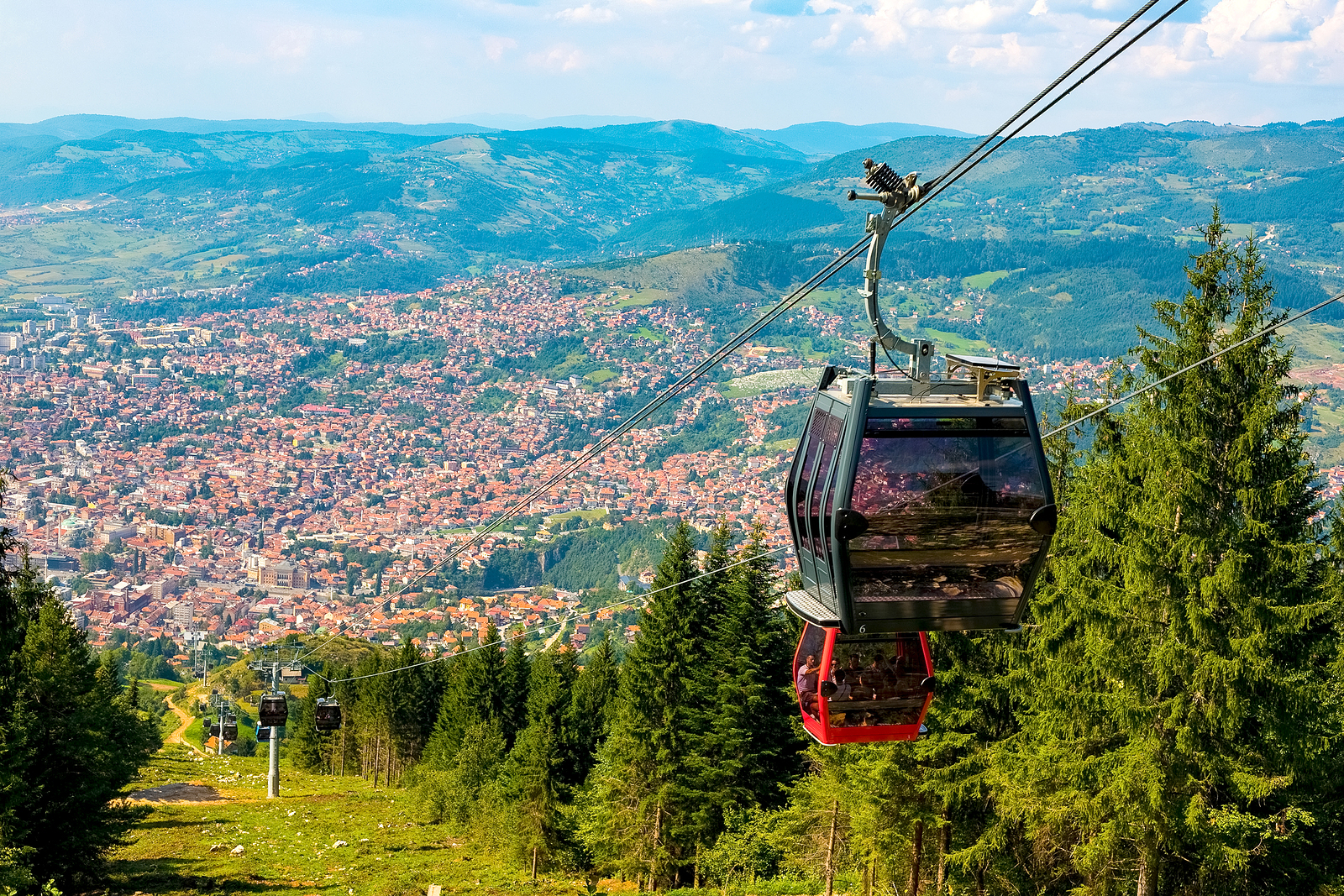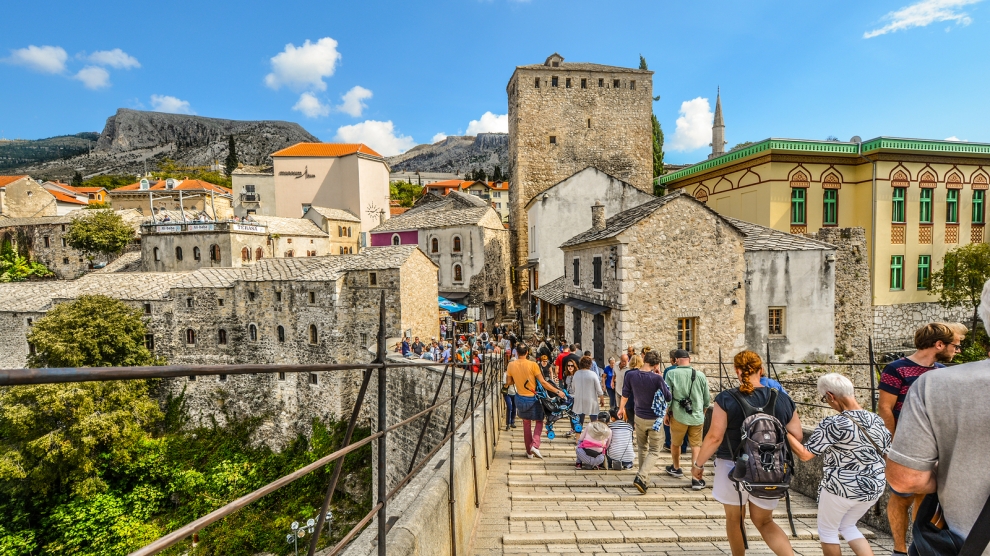The conflict in Bosnia and Herzegovina in the 1990s was the most complicated, deadliest and longest of all the Balkan wars which followed the breakup of the former Yugoslavia. When President Tito passed away in 1980, ethnic and religious diversity, consolidated for a long time, paved the way for growing tensions.
With the evanescing of Communist party control in Bosnia and Herzegovina, a number of nationalistic parties assumed control in the aftermath of the first free elections. In addition to a variety of competing nationalities (Muslim Bosniaks, Catholic Croats and Orthodox Serbs), allegiances from neighbouring Croatia and Serbia and Montenegro intensified the political turmoil even further.
Today, 20 years on, the country known as the Heart-Shaped Land is much more peaceful, and the tourism sector is becoming an increasingly important segment of the country’s economy. While the historical past of the country generates opportunities for dark tourism associated with death and disasters, its beautiful landscape, friendly people and architectural treasures do far more to attract foreign travellers. The challenge for Bosnia and Herzegovina now is to repeating the tourism success of its Croatian neighbours.
Drivers of tourism success
After a long period of political instability, Bosnia and Herzegovina’s tourism sector continues to grow, thanks, in particular, to its dynamic tourism promotional system and warmth of the nation. Since 2013, the government, through the Foreign Investment Promotion Agency (FIPA), has published Investment Opportunities in Bosnia and Herzegovina guides covering the agriculture, metal, energy, tourism, wood, real estate and innovations sectors in order to encourage foreigners to invest in country. For the leisure industry, the report outlines ski and mountain tourism, ecotourism, wellness tourism, religious and cultural tourism, adventure tourism and sea and sun as very propitious domains for investments, and calls on investors to discover “the new unexplored destination.”
“This beautiful country has so much to offer for those people who seek different experiences, away from the crowds, whether they are lovers of skiing, rafting, hunting or patient bird-watching. Those who search for more cultural tourism will be able to relive centuries of history by visiting many vestiges and heritage dating back to Roman, even to prehistoric times,” FIPA notes.
On the other hand, Bosnia and Herzegovina is consistently praised for its people’s friendliness. In 2013, the World Economic Forum (WEF) listed as the eighth friendliest in the world in terms of the way it welcomes tourists.
Moreover, according to WEF, the international openness of Bosnia and Herzegovina, and, in particular, its soft visa policy accounts for the development of tourism. All EU citizens, citizens of EU visa-free regime countries, Azerbaijan, Bahrain, China, Kuwait, Oman, Qatar, Russia and Turkey are exempt from visa requirements when entering the country. Moreover, all EU citizens, citizens of Western Balkan countries, Liechtenstein, Monaco, San Marino and Switzerland may enter using merely a national ID card for a stay up to 90 days. Infrastructure is also improving, not least the number of airports offering international connections.
Tourism in numbers
The number of arrivals by international tourists amounted to more than 777,000 in 2016, more than double the 300,000 reported in 2008. Tourist arrivals reached an all-time high in August 2018 August, with 185,648 visiting the country that month alone. According to the latest figures (for 2017) provided by the Agency for Statistics of Bosnia and Herzegovina, 62.1 per cent of all international tourist arrivals were accounted for by 10 countries: Croatia (10.5 per cent); Turkey (9.8 per cent); Serbia (8.4 per cent); Slovenia (six per cent); Republic of Korea (5.6 per cent); Saudi Arabia (5.2 per cent); Italy (4.7 per cent); Poland (4.3 per cent); Germany (3.7 per cent) and Oman (3.7 per cent). These are followed by China (3.4 per cent), which along with Israel is the fastest growing visitor market.
While looking at tourism statistics for Bosnia and Herzegovina, its handy to keep a close eye on figures related to growth. According to the World Travel and Tourism Council’s Travel and Tourism Economic Impact 2018 country report for Bosnia and Herzegovina, visitor exports generated 843.5 million Us dollars in 2017, accounting for 13.2 per cent of all exports for the year. This is predicted to grow by 6.1 per cent per annum. What’s more, the total contribution of travel and tourism to GDP was 9.6 per cent in 2017 and is forecast to rise to 12.6 per cent in 2028, thanks to an expected rise of about 5.4 per cent per annum.
It should, therefore, not come as a surprise that the World Tourism Organisation defined Bosnia and Herzegovina as one of the three countries in the world with overall tourism market growth potential exceeding 10 per cent annually. Moreover, Bosnia and Herzegovina is also in the list of top 10 countries recording most significant increases in tourist arrivals, according to the UNWTO. In 2017, tourist arrivals and overnight stays increased by 13.7 per cent and 12.3 per cent respectively, in comparison with the same period of the preceding year.

Places to visit
Bosnia and Herzegovina is a crossroads of distinct cultures and civilizations, making the country rich with sacred places. It is, moreover, a destination of adventure, natural beauty, satisfying cuisine and much more besides.
The capital Sarajevo was heavily damaged by shells and bombs during the war in the 1990s, but has since returned to being the vibrant city it was in the past. “Its historic centre blends East and West – visitors can feel they are in Vienna one minute and Istanbul the next,” according to travel writer Jennifer Walker. Unsurprisingly, it is possible to find a mosque, synagogue and Catholic and Orthodox churches all within the same block. Sarajevo is also one of the cheapest capital cities in Europe.
Sarajevo’s War Tunnel Museum is a must-see. When Sarajevo fell under the siege of Serbian forces in 1992, it became isolated from all supplies from the outside world. The tunnel was the only place through which weapons, ammunition, fuel and electricity were made available. As such, the museum represents the survival of Sarajevans from almost four years of isolation. Today, various tours are held in the tunnels to provide background information while photos, newspaper clippings and a short film guides tourists through their journey. The Museum of Crimes Against Humanity and Genocide also concentrates on the darker aspects of the Balkan wars.
Mostar is one of the most picturesque cities in the country. The city is home to the famous Stari Most (Old Bridge), the most visited sight in all Bosnia. The bridge was bombed in 1993, but has since been reconstructed and each summer brave young people dive from its highest point into the river below.
Bosnia and Herzegovina is also home to the second largest Catholic pilgrimage site in the world, Međugorje. The story of the Međugorje pilgrimage dates from 1981, when six teenagers playing in the hills between the villages of Međugorje and Bijakovici claimed to have seen the Virgin Mary. While there is much controversy over the legitimacy of the visions, more than 15 million people have so far visited the small hillside.
Unsurprisingly, Bosnia and Herzegovina is also home to the largest Islamic pilgrimage site (Ajvatovica) in Europe, at Prusac in the centre of the country. The site was named after Ajvaz Dede (Grandfather Ajvaz), a Sufi dervish who prayed to God for 40 days to send rain during a very long period of draught. On the 40th day, rain came to the area, and people, seeing it as a sign of God’s work, began visiting the site.
Stari Most is not Bosnia and Herzegovina only entry in UNESCO’s World Heritage List. The Mehmed Paša Sokolović Bridge and Stećak medieval tombstone graveyards are also present. Located in Višegrad over the Drina River, the bridge is unique example of Ottoman-era architecture. It was built by the Mimar Sinan on the orders of the Grand Vizier Mehmed Paša Sokolović, after whom the bridge is named. Within the borders of Bosnia and Herzegovina lie more than 60,000 Stećak tombstones, whose origins are still contested by the scholars.
The Heart-Shaped Land is also rich with sporting attractions. Banja Luka, through which the river Vrabas flows, is a popular destination for rafting and adventure sports. After the capital Sarajevo hosted the Olympic Winter Games in 1984, the ski resorts which surround the city (Jahorina, Bjelašnica and Igman) became popular tourist attractions. The Vlašić and Kozara mountains are also popular destinations for skiing, snowboarding and eco-tourism.
Room for improvement
While the tourism sector of Bosnia and Herzegovina is growing remarkably, the cities outside the capital still remain unexplored. Moreover, the development of the tourism sector has neglected sustainability. According to the Travel and Tourism Competitiveness Report 2017 by the WEF, Bosnia and Herzegovina is listed 94th and 120th in terms of attention paid to environmental sustainability and sustainability of travel and tourism industry development, respectively. Moreover, the weaker points of tourism sector are also price competitiveness (110th) along with the taxes and airport charges (114th)
The Heart Shaped Land has unquestionably made much of its tourism potential, yet in order for the industry to function more effectively, these areas need to be developed.






[…] Travel | March 16, 2019 | No Comments […]